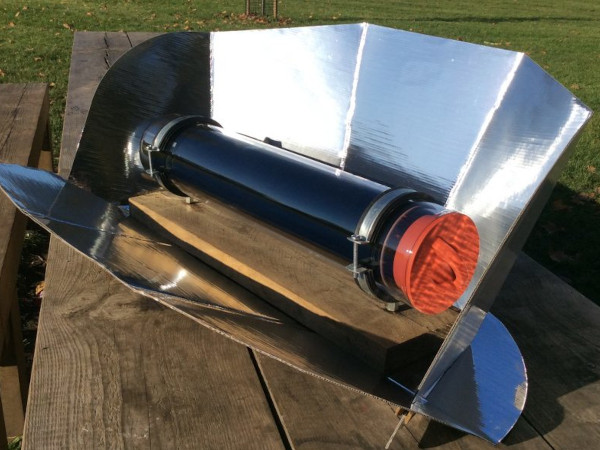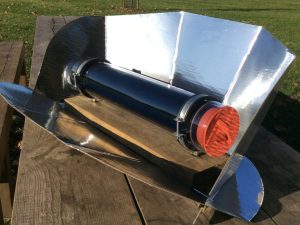“Solar ovens must surely be right up there with the clothes line in making easy and free use of the sun.” – Stuart Ward
Contents
What are solar cookers?
They’re cookers that use sunlight for fuel. They come in different flavours, but they generally have 3 components:
- Black target pot containing what it is that you want to heat – it could be food or it could be water, or you might want to dry something (solar cookers can double as solar driers too).
- Reflector or set of reflectors that focus sunlight on the pot.
- Insulation to retain the heat.
People have been using the sun to heat / dry things for millennia, but only in the last hundred years or so have we been able to build efficient reflectors to really cook well using sunlight.
Most people think of solar cooking as a technology for the tropics – and of course it is, but our advisors have been achieving oven temperatures of 250ºC in the UK.
Solar cooking has been somewhat neglected, compared to other renewable technologies, and there are various reasons for this. In some countries, people tend to favour convenience over sustainability or cost, and don’t want to have to rely on good weather for cooking; in other countries, there are cultural barriers to the use of solar cookers – especially where gender roles are quite specific – i.e. where men don’t tend to get involved with cooking, and women don’t tend to get involved with machinery / technology.

Types of cooker
Solar cookers are also known as solar thermal food processors, although it can also be done via solar photovoltaics. This requires more manufacturing and raw materials, it’s more expensive and there’s more to go wrong. But it can be done.
There are 4 main types of solar (thermal) cooker:
- Parabolic cookers (that have reflectors that look like satellite TV dishes, but with a reflective surface) that focus sunlight onto a single point.
- Box cookers – boxes with 5 insulated sides, and a glass lid. There are reflectors around the lid to reflect extra sunlight into the box. It’s the closest thing to a conventional oven in the solar cooking world.
- Reflective panel cookers – the cheapest type, but they can be quite effective. Their main benefit is that they’re light, and the panels can be folded flat for easy storage and transport – you could put them in a rucksack, for example.
- Evacuated tube cooker – the most modern style and the most efficient way to use the sun for cooking. It’s constructed like a thermos flask, with 2 walls of pyrex glass with a vacuum between them. The black target is on the surface of the inner glass. The same technology is used in some roof-mounted solar hot water installations. For solar cooking, a parabolic trough reflects sunlight onto the tube. Light travels through the outer glass, hits the dark area on the inner glass (which has a special ‘selective surface’ making it very light absorbent, but a poor radiator). These vacuum tubes are very efficient because the only place heat can escape is from the mouth of the tube Using this technology, our advisor has recorded oven temperatures of 220ºC on sunny days in the UK winter.

There are larger, community-scale solar cookers available. These are usually fixed in place, but can cook for 10 to 50 people, or run a local bakery.
Solar cooking systems can be industrial in scale. The largest of these are located in India, and can provide tens of thousands of meals per day. They use arrays of large Scheffler reflectors, up to 16 square metres in area, which track the sun automatically and focus light onto pipes carrying water. The water flashes to steam and is piped to large kitchens where it is used as a heat source.
What are the benefits of solar cookers?
In the tropics, the sun can replace wood as a cooking fuel, and as a fuel to boil water. Dirty water is a real killer in the tropics, and an awful lot of wood is used to boil it. Reducing the need for wood can protect habitat, reduce desertification and carbon emissions, and improve air quality and therefore health.
There’s really not a lot to go wrong, and so they can last a lifetime.

Solar cookers tend to cook for longer and at slightly lower temperatures than a gas or electric stove, and a lot of people say that food cooked this way (as with a slow cooker) tastes better. Our advisors agree (although they’re biased of course).
Once you have the kit, you can heat food for free. This is of particular relevance in parts of Africa, where families can sometimes spend close to half their income on cooking fuel.
They can provide resilience in case of problems with the supply of electricity or gas.
What can I do?
Read up as much as you can first – Joseph Radabaugh’s, Heaven’s Flame remains an excellent source book (free download here). There are plans for how to make your own box cooker, information on what cooks best, and how. Solar Cookers International is a Californian organisation that’s been around since the 1987. They’re another excellent source of information – especially via their wiki. There’s also a Facebook Group dedicated to solar cooking in the UK. Look at what people are cooking with solar, what cookers they use, and ask questions. There are many videos about solar cooking on Youtube. Here’s an unbiased demonstration of the types of solar cooker available:
Getting a solar cooker
It’s easy to make your own solar cooker, that works in the UK summer. There are free DIY plans on the Solar Cooking Wiki. The simplest is the Copenhagen (see video below) – just four square reflectors and a wooden square base. If you prefer to buy, the market is rather restricted. There are no manufacturers in the UK (yet) so you’ll need to import one. It’s best to decide what you expect to cook with it, then do some research or ask one of the advisors whether your plans are realistic. For example, box solar cookers work during the summer in the UK, but not in the colder months, whereas evacuated tube cookers will cook even when there’s snow on the ground, as long as the sun is out.
Safety
When you use a solar cooker, observe the same precautions as you would in your own domestic kitchen. The pots, food, and liquids will be hot enough to burn or scald you, and glass components will shatter if you drop them. In the lower-powered solar cookers, especially in partially cloudy conditions, make sure the food has been heated, all the way through, to at least 65ºC. There’s another hazard you don’t usually encounter while cooking – dazzling reflected sunlight. Always wear sunglasses to protect your eyes, and make sure others do the same.
Integrated cooking
There’s an obvious disadvantage with solar cookers – you can’t cook with them when it’s not sunny. But there are two other technologies that can be used alongside solar cookers – rocket stoves, and retained heat cookers. Using these three technologies together is known as ‘integrated cooking’, the lowest-impact cooking available. This combination enables you to cook at any time, rain or shine, without fossil fuels. If it’s sunny, use the solar cooker. If not, use the rocket stove. To keep your food hot (from the rocket or solar stove) for up to five hours, or reduce the wood you need for the rocket stove, or free up the solar cooker for another dish, use the retained heat cooker.

Integrated cooking can provide you with resilience in the face of fuel shortages, electricity blackouts, all the way up to societal collapse. You’ll always be able to have hot food and safe water if you have a solar cooker, rocket stove, haybox and access to small amounts of firewood.
Cooking this way requires more thought than fossil fuel cooking – you have to watch the weather, cook outside, light fires, plan ahead, and get things going before you’re hungry. This sounds exhausting, but remember that reflective panel cookers and box cookers cook ‘low and slow’, so your food won’t burn. This means that you can put your food into the cooker, and walk away, returning every hour or so to point your cooker at the sun again.

The faster/hotter solar cookers – parabolics and tube cookers – require more attention, a bit more like cooking in a conventional kitchen. Rocket stoves require close attention, and a constant supply of small twigs, but they cook very fast, and you can always complete the cooking process using your retained heat cooker. A good retained heat cooker will keep your food above 65ºC for four to five hours, so you can eat when you want to.
Specialist(s)
Thanks to Dave Oxford and Stewart MacLachlan of Slicksolarstove.com for information and images.
The specialist(s) below will respond to queries on this topic. Please comment in the box at the bottom of the page.

Stewart MacLachlan is an urban solar cook living in London. Co-founder of SLiCK, Architect and specialist in deep green building, MSc in advanced energy architecture from UEL. UK distributor for EcoZoom rocket cookstoves. Solar cooking for over a decade and using whatever limited means on hand to spread awareness, know-how and to increase the number of ‘solar cooks’ in the UK and around the world.

Dave Oxford lives in Cornwall. Co-founder of SLiCK. MSc in advanced energy systems from CAT/UEL. Solar cooking for over a decade. Determined to raise awareness of solar cooking in the UK. Currently working on a series of Youtube videos about solar cooking.



1 Comment
That linear solar cooker above did not have an evacuated tube, so that means that the only challenge is building the linear parabolic.